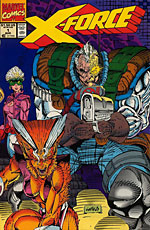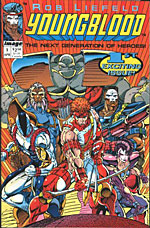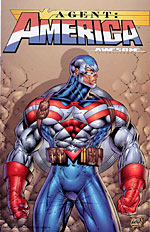
For comic book fans of a certain age, Rob Liefeld is a lot like hair metal; back in the day you were utterly convinced he was the coolest thing ever, now the threat of torture couldn't get you to admit you ever read one of his comics, let alone enjoyed it.
For a few years in the early 90s, Liefeld was the very image of comic book success. He moved from strength to strength, selling millions of copies of his books, co-founding Image studios, and making a fortune in the process. He even managed to star in a jeans commercial.
Not bad for a kid barely out of his teens without any formal training behind him. A comic book fan from early on, Liefeld started drawing comic books when he was seven years old. By eighteen he was working as a professional artist for DC comics. He soon moved to Marvel comics, where his work on NEW MUTANTS and its follow up title X-FORCE moved him into the top rank of artists.
A few years later, he was known as the most hated man in comics. A string of failed studios were behind him, and a brief reunion with Marvel comics led to a lawsuit. His output was erratic, and what he did publish sold a fraction of what he moved in his heyday. And he was not even thirty years old.
Now more than a decade later, he's back at Marvel, working on the newly relaunched version of X-FORCE, the series that made him a star.
LANDMARKS
1987 - Just out of high school, Liefeld landed his first work at DC comics, a cover for CHECKMATE. Soon after, he was tapped to do the art chores for a five issue HAWK AND DOVE mini series. The series was a moderate success, and Liefeld was already starting to make waves and get noticed.
1988 - Liefeld moved to Marvel and was given the moribund NEW MUTANTS series with a mandate to do whatever he felt like doing with it. What he felt like doing was creating a character named Cable.
Cable, a hulking mutant with one eye, enormous muscles, and even more enormous guns, was an immediate hit with fans. Dropping the soap opera theatrics and pumping up the action sent NEW MUTANTS climbing up the sales charts. Liefeld promptly packed the lineup with a string of mysterious characters with big guns and shady, possibly non-existent pasts, including the fan favorite, jib-jabbing assassin DEADPOOL. The book changed so radically that Marvel decided to reboot the series.
 1991 - Marvel ended NEW MUTANTS with issue 100 to start X-FORCE, illustrated by Liefeld and co-plotted by Liefeld and Fabian Nicieza. Less than two years after taking over the low selling NEW MUTANTS, Liefeld made the first issue of X-FORCE one of the best-selling comics of all time. The success of X-FORCE started a trend for mysterious pasts, huge guns, and ponytails.
1991 - Marvel ended NEW MUTANTS with issue 100 to start X-FORCE, illustrated by Liefeld and co-plotted by Liefeld and Fabian Nicieza. Less than two years after taking over the low selling NEW MUTANTS, Liefeld made the first issue of X-FORCE one of the best-selling comics of all time. The success of X-FORCE started a trend for mysterious pasts, huge guns, and ponytails.
1992 - Liefeld announced his plans to publish a creator-owned book with Malibu comics called THE X-TREMISTS. Marvel, annoyed at Liefeld's use of the X logo on a non-Marvel property, called him on the carpet, informing him that if he tried to do work for other companies, he could and would be fired.
Marvel had long maintained that the brand was more important than the individual creators involved, an attitude that was alienating many of their top artistic talents. Todd McFarlane had seen Marvel use his name to sell books even while telling him that the title was what sold them, not his art. His frustration was shared by Jim Lee, Marc Silvestri, and, of course, Rob Liefeld.
These creators came together to create Image Comics. Image was created to allow the partners the artistic freedom they were deined at Marvel and DC. The company itself would own no intellectual property outside the image "I", and the creators could do as they pleased and reap the profits.
The gamble paid off; Liefeld's YOUNGBLOOD, the first comic offered by Image, broke sales records. It was a record that was to be broken again one month later by the release of Jim Lee's WILDCATS, and then again that same month by the release of Todd McFarlane's SPAWN. Image was an immediate, unprecedented success. Even the weakest of the Image lineup, Jim Valentino's SHADOWHAWK, sold more than three quarters of million copies.
Liefeld was a superstar. Image had made him a millionaire, and Hollywood began making advances toward him. Liefeld even appeared in an advertisement for Levi's jeans directed by Oscar-nominated director Spike Lee.
 1994 - The Image boom time didn't last long. By 1994 Liefeld was able to create a buzz among his fans by announcing that he was returning to comics after an eight month hiatus - to finish YOUNGBLOOD issue six, a comic originally solicited in 1993.
1994 - The Image boom time didn't last long. By 1994 Liefeld was able to create a buzz among his fans by announcing that he was returning to comics after an eight month hiatus - to finish YOUNGBLOOD issue six, a comic originally solicited in 1993.
Nearly all of the Image partners faced similar problems. Books were late, some never came out at all, and many had to be resolicited over and over again. The freedom afforded by Image also came with all the perils of having no one to keep the founders on track. Added to this were the constant opportunities their stardom afforded them for distraction. The work fell farther and farther behind, and sales dropped.
Even so, Liefeld remained a viable force in the comics industry, and he was becoming well known for his flirtation with Hollywood. At any given time he had several projects under option, from the popular YOUNGBLOOD to the still non-existent DOOM'S IV.
1996 - Marvel rebooted many of its mainstay characters in an event called Heroes Reborn. Captain America, The Avengers and others were removed from the regular Marvel universe and dropped into their own worlds. In a concept that foreshadowed the coming of the Ultimate line, these characters were rebooted without previous continuity in their own universe.
Liefeld and Lee were asked to return to Marvel to head up the Heroes Reborn launch. It was their first return to Marvel since they'd left to form Image four years before. The relaunches were met with resistance from the fans, and problems started for Liefeld almost immediately.
He was contracted for a twelve issues of CAPTAIN AMERICA, but he almost immediately fell behind on art duties. His plots were widely reviled as hokey rehashes of old stories, and his art style had fallen from vogue. After six issues, Marvel dropped Liefeld from the book.
In this same time period, trouble was brewing at Image comics. Marc Silvestri took his profitable Top Cow line out from under the umbrella of Image Comics, citing personal differences with an unnamed member of the company. Meanwhile, Liefeld had created Maximum Press as an outlet for projects he wanted to pursue outside the Image group, and was accused by the other partners of misusing Image funds and resources to promote and finance his new venture and not having Image's best interests in mind.
In early September, Liefeld issued a press release stating he was resigning his position at Image and leaving the group. Nearly simultaneously, the Image partners issued a press release stating that they had fired Liefeld. The other partners had already voted once to remove Liefeld from the group, a move he protested on the grounds that he was given too short a notice period. His resignation came only minutes before the second meeting that would have forced him out.
Liefeld left to found Awesome Comics, and Marc Silvestri and Top Cow returned to the Image fold.
1997 - Liefeld wandered into hot legal waters. He sued his former Image partners for libel, slander, wrongful termination and a host of other accusations to the tune of nearly eight million dollars. His partners promptly responded by counter-suing for mismanagement and misuse of corporate funds.
 Around the same time, Liefeld began work on a series called AGENT: AMERICA for Awesome Comics with his CAPTAIN AMERICA writing partner Jeph Loeb. The series was going to use the ideas the pair had come up with for the failed CAPTAIN AMERICA series. Liefeld then acquired the rights to FIGHTING AMERICAN, a Joe Simon and Jack Kirby creation from the 60s. Both artistically and plot-wise, the series had many similarities to CAPTAIN AMERICA. So many, in fact, that Marvel sued Liefeld for copyright violation.
Around the same time, Liefeld began work on a series called AGENT: AMERICA for Awesome Comics with his CAPTAIN AMERICA writing partner Jeph Loeb. The series was going to use the ideas the pair had come up with for the failed CAPTAIN AMERICA series. Liefeld then acquired the rights to FIGHTING AMERICAN, a Joe Simon and Jack Kirby creation from the 60s. Both artistically and plot-wise, the series had many similarities to CAPTAIN AMERICA. So many, in fact, that Marvel sued Liefeld for copyright violation.
Liefeld eventually reached settlements in all his suits. He and his Image partners settled out of court for an undisclosed sum. The case with Marvel went to court, where it as eventually decided that he could go on publishing the character of Fighting American so long as he changed it to be less similar to Captain America. Among the changes specified was that Fighting American could not throw his shield. Both parties claimed a dubious victory over the other.
2000 - Their legal differences now resolved, Liefeld returned to work for Marvel once again. He took over scripting and art duties for a run on WOLVERINE, a character with a penchant for violence and a muddled, mysterious past - two Liefeld staples. Liefeld also returned to his original Marvel sensation, Cable, taking the character's solo title through its 75th issue, finally resolving some of the storylines that had started back when he originally worked on the character.
RECENT DAYS
In mid-2004, Liefeld returned to his roots at Marvel, drawing the newly rebooted X-FORCE with his old writing partner, Fabian Nicieza. Awesome Entertainment still publishes comics through a company named Arcade, and Liefeld recently published the start of a new YOUNGBLOOD series scripted by Mark Millar, and announced YOUNGBLOOD: IMPERIAL with one of the new generation of comic stars, writer Robert Kirkman.
Liefeld still has a number of irons in the fire in Hollywood, most recently selling SHRINK, about a psychiatrist to superheroes, to Jennifer Lopez' s production company. As yet, none of projects have made it out of development.
NINTH ART RECOMMENDS
X-FORCE: BIG GUNS (2004): Rob Liefeld's artwork may not be to everyone's tastes, but if you want to get an idea of the work that made Liefeld comics' first superstar artist, and of the sort of comic art that set the tone for the 90s and led to the founding of Image, this Marvel trade paperback will tell you everything you need to know. It collects the first four issues of X-FORCE from 1991, as well as the crossover sixteenth issue of Todd McFarlane's SPIDER-MAN #16.
LIEFELD ON LIEFELD
"If I wanted to draw like the legion of photo-tracers/screen saver artists out there, I'd do it in a heartbeat. I can draw a portrait with the best of them, but if I want my comics realistic, I'll go see the film." - In an interview with JD Lombardi at Wizard World Chicago 2004.
"The emotional connection is everything; if you don't have that then you have nothing. The people who dig what I do connect with it, reverse that for those that don't. It's really that simple." - Ibid.

This article is Ideological Freeware. The author grants permission for its reproduction and redistribution by private individuals on condition that the author and source of the article are clearly shown, no charge is made, and the whole article is reproduced intact, including this notice.


